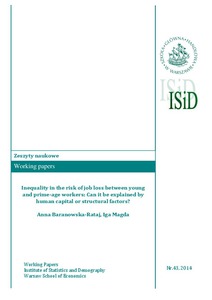Inequality in the risk of job loss between young and prime-age workers: can it be explained by human capital or structural factors?
"In this paper we identify the determinants of the gap in job stability between young and prime-age workers. Using recently developed decomposition techniques and the panel dimension of data from the Polish Labor Force Survey, we examine to what extent age heterogeneity in job stability is shap...
| Main Authors: | , |
|---|---|
| Institution: | ETUI-European Trade Union Institute |
| Format: | TEXT |
| Language: | English |
| Published: |
Warsaw
2014
SGH Warsaw School of Economics |
| Subjects: | |
| Online Access: | https://www.labourline.org/KENTIKA-19116357124919345399-inequality-in-the-risk-of-job-.htm |
| Summary: | "In this paper we identify the determinants of the gap in job stability between young and prime-age workers. Using recently developed decomposition techniques and the panel dimension of data from the Polish Labor Force Survey, we examine to what extent age heterogeneity in job stability is shaped by differences in the composition of young and prime-age workers with respect to individual and job-related characteristics, and to what extent it is driven by different effects of those characteristics on the risk of job separation. Our results show that while differences in education and experience between young and prime-age workers are important, these differences explain only one-third of the gap in job stability. A substantial part of the gap is related to the propensity of young people to work in the most volatile segments of the labor market. Young workers are more likely than prime-age workers to work under a fixed-term contract in a small firm in the private sector, and in an industry that has high rates of both job creation and destruction. Because large numbers of young people have a job in this relatively narrow segment of the labor market, their employment opportunities are very sensitive to changing economic conditions. We also find that the public sector offers prime-age workers a higher level of employment protection than the private sector, but that young people who work at state-owned firms are at higher risk of losing their job than their counterparts who are employed by private firms. This asymmetric effect of public sector employment substantially increases the gap in job stability levels between young and prime-age workers in Poland." |
|---|---|
| Physical Description: | 39 p. Digital |

